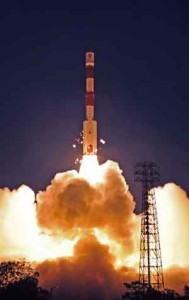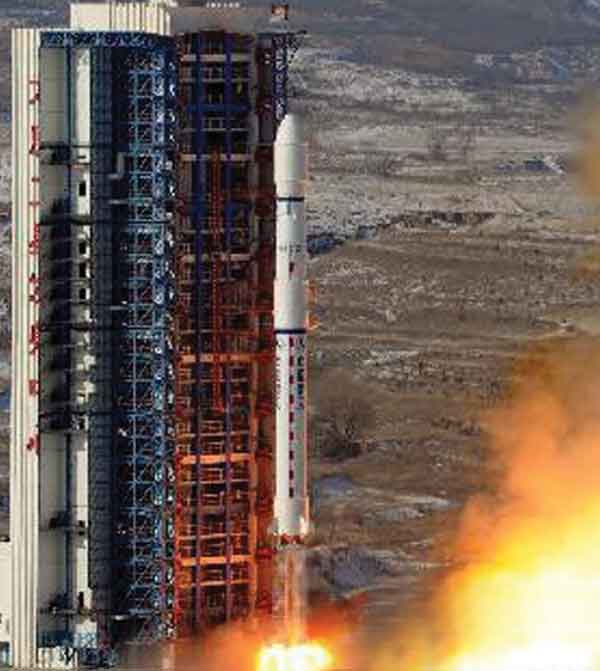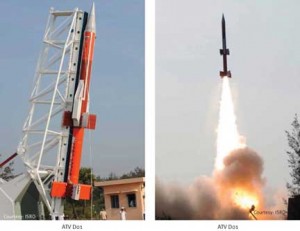Soviet Space Weapons
During the Cold War, the satellite launch capabilities of the Soviet Union were as good, if not better, than that of the US. Research in the Soviet Union on the development of space related weapon systems was proceeding more or less on track parallel to that in the US. In 1961, the Soviet Union undertook the development of an Interceptor Satellite (IS). The concept involved launching the killer satellite into the same orbit as the target satellite. Thereafter, the requirement was to manoeuvre the killer satellite into the vicinity of the target, say about less than a kilometre, to be destroyed by shrapnel generated through explosion of a warhead on the killer satellite. Declared operational in 1973 after extensive testing, the programme was formally closed down in 1983 and has not been heard of since then.
In the 1970s and 1980s, there were reportedly cases of US Spy Satellites being temporarily blinded for inexplicable reasons. The needle of suspicion naturally pointed to the Soviet Union. Soviet scientists also dabbled with research in Charged Particle Beam Weapon System and possible use of space stations as launch platforms for weapons against satellites in orbit. However, these efforts did not meet with much success. In the 1980s, the Soviet Union did develop an ASAT System using the MiG 31 aircraft as the launch platform.
Backed by her (China) powerful national will and immense resources, China’s plans to put a man on the moon by 2024 will, in all likelihood, succeed.
There is not much clarity on the level of Chinese success in the development of ASAT capability as their activities continue to be shrouded in secrecy. However, as per reports appearing in the media, China appears to have a laser weapons system deployed in Xinjiang province, though details of its power output and overall capability to blind or destroy a satellite is not known with any degree of certainty. In August 2006, it is believed that some US intelligence satellites transiting over Chinese territory were targeted by high powered ground-based laser weapons believed to be located in China.
The efficacy of the laser weapon has not been revealed and in fact doubts linger as to whether the supposedly directed beam was meant to temporarily neutralise the satellite or whether it was part of a ground-based missile guidance system. On January 11, 2007, in a live test of a ground-based SC 19 ASAT, China successfully destroyed one of its own life expired weather monitoring satellites in a polar orbit at an altitude of over 650 km from the surface of the earth. Quite understandably, there was global concern over this development, not only on account of the strategic implications of the escalating arms race in space but also on account of the vast quantities of debris generated by the destruction of the satellite.
Space is being polluted by man-made debris at an alarming rate and as yet, there is no known technology or method for the removal of debris orbiting in space.
China is aggressively seeking foreign collaboration in her efforts to develop ground-based ASAT capability both through hard and soft kill as also the facility to track satellites in Low Earth Orbit and interfere with transmissions from space-based platforms such as the existing Global Positioning System or future navigation systems such as the European Galileo or the Russian GLONASS.
Given China’s determination and national focus on emerging as a superpower, there should be little doubt about her intentions to remain abreast of, if not ahead, in the emerging arms race in space. China’s ambitions to be second to none in the space race can be gauged from the fact that she has already sent several astronauts into space albeit a little later than others.
Backed by her powerful national will and immense resources, China’s plans to put a man on the moon by 2024 will, in all likelihood, succeed.
India’s Space Endeavour
The Indian space programme, which began in 1962 at the Thumba Equatorial Launching Station located near a seaside fishing hamlet on the Kerala coast, was formally inaugurated on November 21, 1963 with the launch of an American-manufactured Nike Apache sounding rocket. However, the seeds of the truly indigenous space programme were sown by the launch of a `pencil rocket` 10 kg in weight carrying 350 grams of fuel, just a few kilometres into the sky. The largest space launch vehicle with the Indian Space Research Organisation (ISRO) today is the Geosynchronous Satellite Launch Vehicle (GSLV) which is around 50 metres tall and has a lift off weight in excess of 400 tonnes.
For about five decades, ISRO has recorded some remarkable successes as also a few spectacular failures that are not uncommon in space exploration. Remarkably, ISRO has learnt quickly and each time successfully turned defeat into victory. With its first satellite launch in 1975, to date ISRO can be credited with sending around 40 satellites into orbit, which includes 16 on behalf of foreign customers.
However, despite decades of scientific endeavour, colossal investments and notable successes in the exploration of space, no nation has as yet an effective or proven space-based weapon and truly operational space combat capability.
On February 02, 1968, Vikram Sarabhai, regarded as Father of the Indian Space Programme, defined the focus of the Indian space endeavour in the following words, “There are some who question the relevance of space activities in a developing nation. To us, there is no ambiguity of purpose. We do not have the fantasy of competing with the economically advanced nations in the exploration of the moon or the planets or manned space flights. But we are convinced that if we are to play a meaningful role nationally and in the comity of nations, we must be second to none in the application of advanced technologies to the problem of man and society which we find in our economy.”
Since the enunciation by Vikram Sarabhai of what can be regarded as policy, in the last four decades, achievements by ISRO and their future programmes indicate that there has been a clear departure from India’s position stated initially. The successful first commercial launch on April 23, 2007 was indeed the turning point wherein ISRO inserted into orbit an Italian satellite with the help of the Polar Satellite Launch Vehicle (PSLV) which is the primary workhorse of the space agency with a payload capacity of around 1.7 tonnes.
With the successful development of the larger and more powerful GSLV, ISRO has the capability of inserting two-ton payload into geo-synchronous orbit. However, with the successful test of the S200 solid fuel booster early this year, the third most powerful in the world, payload capability for a geo-synchronous transfer orbit will be enhanced to four tonnes and ten tonnes for a near-earth orbit at an altitude of about 300 km.
After the experience gained from the partially successful moon mission Chandrayaan I, ISRO is moving forward with the second moon mission designated as Chandrayaan II scheduled for launch in 2013. This mission will consist of a Lunar Lander that, after a soft landing on the surface of the moon, will discharge a rover to collect rock and soil samples for chemical analysis. Chandrayaan II would be followed by launch of a week-long manned space mission in 2016 which will have a capsule designed to carry two Indian astronauts into space.
 ISRO plans to establish a training facility for astronauts as also an additional launch pad at Sriharikota in Andhra Pradesh. Further, intentions are to land a man on the moon by 2020, and then to undertake deeper forays into space beginning with the exploration of Mars as well as conduct studies on the concept of a lunar base.
ISRO plans to establish a training facility for astronauts as also an additional launch pad at Sriharikota in Andhra Pradesh. Further, intentions are to land a man on the moon by 2020, and then to undertake deeper forays into space beginning with the exploration of Mars as well as conduct studies on the concept of a lunar base.
ISRO has a variety of ongoing and future satellite launch programmes in the civilian domain such as for monitoring of forest fires, study of greenhouse gases, vegetation and disaster management. Cartostat series of remote sensing earth observation satellites are launched periodically in polar orbit for mapping. INSAT series of communication satellites are parked in geo-stationary orbits to provide Direct-To-Home (DTH) countrywide satellite television coverage, telecommunications and sat-phone services, distant education, telemedicine facilities, broadband connectivity ATMs and cellular phone services.
In an effort to introduce new technologies, ISRO has recently tested a new generation high performance sounding rocket designated as the Advanced Technology Vehicle (ATV D01). Weighing three tonnes at lift off, the ATV D01 is designed to test futuristic air breathing propulsion technology. The ATV D01 was fitted with a passive Supersonic Combustion Ramjet (Scramjet) engine combustor module. This technology has the potential to reduce launch costs substantially as it derives the oxygen required for combustion from the atmosphere thus reducing the weight of fuel to be carried.
From the experience so far, it appears that with available technology, the concept of placing beam weapons on space-based platforms is likely to continue to remain a distant possibility.
As a purely commercial effort, in January 2009, amidst much controversy, ISRO launched a surveillance satellite for Israel designated as TecSAR. Few months later, ISRO launched a 300-kg Radar Imaging Satellite (RISAT2) built by Israel Aerospace Industries for India. Inserted into a 550 km orbit around the earth, the RISAT2 is the first imaging satellite with Synthetic Aperture Radar (SAR) deployed by India. The SAR gives the satellite all weather day and night surveillance capability.
Apart from the normal functions of an imaging satellite, the RISAT2 has defence applications, official denials notwithstanding. ISRO is developing its own version of SAR equipped surveillance satellite. Suitable for both civilian and military application, the RISAT2 will signify a quantum jump in the technological advancements so far achieved by ISRO.
Not to be left behind, ISRO, along with DRDO and other research institutions, is in the process of developing as a Technology Demonstrator, a 25 tonne reusable aircraft capable of operating from conventional airfields. Designated as Aerobic Vehicle for Hypersonic Aerospace Transportation nicknamed AVATAR, it would provide a low cost option for launch of military and civilian satellites. Powered by a Scramjet, it will be capable of delivering a satellite payload of up to one tonne into a 100-km earth orbit.
Indian ASAT
With India’s assets in space proliferating and disconcerting developments in the neighbourhood on the rise, it is only logical that India would have to adopt appropriate measures to provide adequate safeguards for her space assets as well as effective countermeasures against potential threats. Indian scientific establishments are currently engaged with the development of weapon systems for “electronic or physical destruction of satellites in both Low Earth Orbit and the higher Geo-synchronous Earth Orbits as part of the Indian Ballistic Missile Defence Program expected to be in place by 2014.
Conclusion
There is little doubt that space is the final frontier and control of the next military high ground not only to protect own assets in space but also to prevent potential adversaries in wresting advantage will be the new imperatives in space not only for the superpowers but other nations aspiring to use space for peaceful purposes. Space superiority like Air Superiority will be the sine qua non for domination of space in the centuries ahead.
However, despite decades of scientific endeavour, colossal investments and notable successes in the exploration of space, no nation has as yet an effective or proven space-based weapon and truly operational space combat capability. The ongoing programmes are yet in the experimental stage.
The space endeavour by nations has been constrained by two major factors – infinite technological complexity of programmes and not easily affordable costs. From the experience so far, it appears that with available technology, the concept of placing beam weapons on space-based platforms is likely to continue to remain a distant possibility. Challenges before space-faring nations to prepare for warfare in space will thus be formidable and daunting, at least in the foreseeable future.






